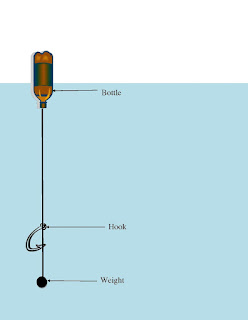Monday, August 7, 2017
Another Fishing Method on the Local Scene Stirs Childhood Memories
I was fishing the West Neck Creek shoreline during our tourney two days ago when what should appear before me but a couple of boys in a johnboat running their jug-fishing lines. My immediate thought was that I just had happened upon a couple of young fellas who might be breaking the law.
There's a good reason why I had that thought. As a young lad growing up in my hometown of Oswego, KS, I remember one summer in the 1950s, when my dad's Uncle C. came to town from Kansas City for a visit. As usual, he wanted Pop to take him fishing, but not with rod and reel.
No, sir. Uncle C. wanted Pop to take him jug fishing in the Neosho River. And he had come fully prepared for the occasion. His car was loaded with 5-gallon glass jugs. There was just one problem: At that time and to this day, too, I think, Kansas has a thing about jug fishing. In short, it's illegal--a fact I'm not sure Dad ever divulged to Mom, because he had to have known how she would react to that kind of news.
Nevertheless, Pop and Uncle C. readied the bottles and, at the agreed upon time, set out for a secluded stretch of the river. I had been all over Dad for a couple of days to take my brother and me along, and in due time, he had caved, so I was all set to get a lesson about a new kind of fishing (new to me, that is).
In its simplest form, jug fishing is an unlimited class-tackle method of fishing that uses lines suspended from floating jugs to catch fish in lakes or rivers. Often, a large number of jugs are used. In many states, a fisherman can use up to 20 jugs. Big catfish often are the sought-after species.
I can't begin to tell you how much I enjoyed seeing what happened to those floating bottles when a big catfish would grab the bait attached to one of them. It then was up to Dad and Uncle C. to go chase down their prize in Dad's rowboat. Suffice it to say the day was a total success...without, I might add, any visits from John Law.
From that day until this past Saturday, I hadn't seen any more jug fishing, so you can imagine my surprise when I came around a blind corner in West Neck Creek and saw all those floating jugs. That element of surprise, however, quickly was replaced by questions about the legality of what I was witnessing. For that reason, I contacted Chad Boyce, a fish biologist with the Virginia Department of Game and Inland Fisheries, and got answers to my questions.
It turns out that jug fishing is a legal means of taking catfish and other nongame fish in Virginia. According to Chad, "Each float is required to be marked with the owner's name and fishing-license number (I think). I believe each fisherman is allowed to use 20 noodles (another name for jug lines) at a time, and they must stay within sight of the floats while fishing them," he said.
Chad provided the following language from the official regulations:
"Trot lines, jug lines, or set poles (limb lines) may be used to take nongame fish and turtles, provided they are not baited with live bait (worms are permissible), except on designated stocked trout waters, Department-owned lakes, and within 600 feet of any dam. Live bait, other than game fish, may be used on trot lines to take catfish in Carroll, Dickenson, Giles, Grayson, Montgomery, Pulaski, and Wythe Counties, and in the Clinch River in Russell, Scott and Wise Counties. (See page 13 for South Holston Reservoir.) Any person setting or possessing the above equipment shall have it clearly marked by permanent means with his or her name, address, and telephone number, and is required to check all lines and remove all fish and animals caught each day. Remove all trot lines, jug lines, or set poles from public waters when not in use. Additional requirements for jug lines: Defined as a single hook, including one treble hook and line attached to a float. Jug line/noodle sets on public waters shall be restricted to 20 per angler and must be attended (within sight) by anglers at all times. Also, in addition to being labeled with the angler's name, address, and telephone number, jugs/noodles shall be labeled with a reflective marker that encircles the jugs/noodles to allow for visibility at night."
I'm not advocating that anyone take up jug fishing. Rather, I'm just making everyone aware to be on the lookout for jugs now, as well as crab pots, on the North Landing and its tributaries. This is the first time in my 40 years of local bass fishing that I've ever seen anyone using this method. I suggest that it's anyone's guess how long it will last, or if it perhaps will catch on the way kayak fishing has in recent years. Bottom line: The waterways could have just gotten a little more crowded...for the long haul...or not.
Subscribe to:
Post Comments (Atom)





No comments:
Post a Comment